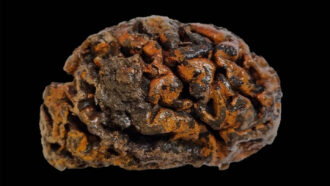Analyze This!
Exploring science through data, graphs, visualizations and more.
-
 Earth
EarthAnalyze This: Smartphone data may help improve GPS
Data from millions of phones helped fill in maps of the ionosphere, an atmospheric layer that can muddle radio signals key for navigation systems.
-
 Animals
AnimalsAnalyze This: When do cats move like liquids?
Cats flow through narrow openings but hesitate before short openings. That may help them avoid unseen danger in the wild.
By Carolyn Wilke and Andrea Tamayo -
 Ecosystems
EcosystemsAnalyze This: In movies, wetlands often get a bad rap
Swamps in films are often linked to danger, death and strange things. But movies also highlight wetlands’ biodiversity and resources.
-
 Psychology
PsychologyAnalyze This: Skipping through videos may increase boredom
Contrary to what people often expect, fast-forwarding or switching videos may leave viewers more bored and less satisfied.
-
 Fossils
FossilsAnalyze This: How big was the biggest T. rex?
Only around 80 fossil Tyrannosaurus rex skeletons have been found. They probably don’t include the biggest T. rex that ever lived.
-
 Earth
EarthAnalyze This: Why do atmospheric ‘ghosts’ glow green after red sprites?
Green ghosts — blurs of light that sometimes follow lightning — get their color from oxygen and metals in space dust.
-
 Planets
PlanetsAnalyze This: Jupiter’s Great Red Spot is shrinking
If the windstorm keeps dwindling, the Great Red Spot could someday disappear — like an earlier spot observed in the 1600s.
-
 Archaeology
ArchaeologyAnalyze This: Human brains can last thousands of years
Ancient brains may not be rare finds. An analysis of over 4,000 preserved human brains reveals five processes that protect against decay.
-
 Earth
EarthAnalyze This: Where are U.S. earthquakes most likely?
A model used data on historical quakes and measurements from active faults to forecast risks of damaging earthquakes in the next 100 years.
By Carolyn Wilke and Nikk Ogasa -
 Space
SpaceAnalyze This: A recently spotted space object is puzzling scientists
A pulsar’s invisible partner could be an oddly heavy neutron star or a very light black hole.
By Carolyn Wilke and Adam Mann -
 Animals
AnimalsAnalyze This: Marsupial gliders may avoid the ground to dodge predators
It has been unclear why gliding evolved in marsupials. To search for clues, researchers strapped activity trackers to some of these cryptic creatures.
-
 Oceans
OceansAnalyze This: Climate change may worsen the spread of ocean noise
Some parts of the ocean may become five times as loud in the future.